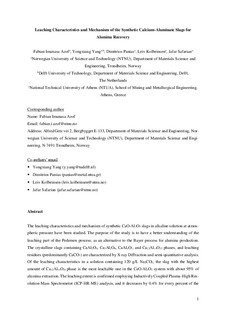Leaching characteristics and mechanism of the synthetic calcium-aluminate slags for alumina recovery
Journal article, Peer reviewed
Accepted version

Åpne
Permanent lenke
http://hdl.handle.net/11250/2594132Utgivelsesdato
2019Metadata
Vis full innførselSamlinger
- Institutt for materialteknologi [2527]
- Publikasjoner fra CRIStin - NTNU [37703]
Sammendrag
The leaching characteristics and mechanism of synthetic CaO-Al2O3 slags in alkaline solution at atmospheric pressure have been studied. The purpose of the study is to have a better understanding of the leaching part of the Pedersen process, as an alternative to the Bayer process for alumina production. The crystalline slags containing CaAl2O4, Ca3Al2O6, CaAl4O7, and Ca12Al14O33 phases, and leaching residues (predominantly CaCO3) are char- acterized by X-ray Diffraction and semi-quantitative analysis. Of the leaching characteristics in a solution containing 120 g/L Na2CO3, the slag with the highest amount of Ca12Al14O33 phase is the most leachable one in the CaO-Al2O3 system with about 95% of alumina extraction. The leaching extent is confirmed employing Inductively Coupled Plasma-High Resolution-Mass Spectrometer (ICP-HR-MS) analysis, and it decreases by 0.4% for every percent of the bayerite (Al(OH)3) formation during the leaching. The less stable form of CaCO3, i.e., vaterite, is formed over the leached slag particles that consist 33–49 wt% CaO, while Ca3Al2(OH)12 (tricalcium alumina hydrate) precipitated at relatively low concentrations (< 6 wt%) in all residue. The non-bridging oxygen (NBO) over tetrahedral structure (T) index shows that the atomic structure may affect the leaching extent of the slags, the lower NBO/T index of the phase is the more difficult for the phase to leach or depolymerize. However, the Ca12Al14O33 phase is an exception case where it has “free” O-ions at the center of the cage structure, which makes it easily depolymerize, therefore, the NBO/T index for the Ca12Al14O33 phase becomes irrelevant. Furthermore, the morphology and size evolution of the obtained residue measured with laser particle analyzer indicates the agglomeration behavior of the residue particles during the leaching process. Leaching characteristics and mechanism of the synthetic calcium-aluminate slags for alumina recovery
